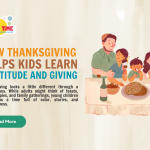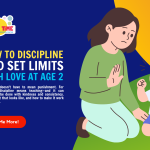Your 2-year-old is beginning to explore independence, test boundaries, and assert their (often very loud) opinions. This is all part of typical development—and while it may feel like defiance, it’s really your toddler learning how the world works.
Toddlers thrive when there’s structure. Clear limits give them something solid to push against as they figure out how to manage their feelings and impulses. Without boundaries, the world can feel confusing and overwhelming—which often leads to more meltdowns, not less.
Discipline doesn’t have to mean punishment. For toddlers, discipline means teaching—and it can absolutely be done with kindness and consistency. Here’s what that looks like, and how to make it work in daily life.
When Is Discipline Too Strict—or Too Gentle?
Too-strict discipline—like yelling, spanking, or constant “no’s”—can lead to fear and shut down your child’s ability to learn from their actions. On the flip side, being too permissive and letting everything slide can create chaos and insecurity.
The goal is to find a healthy middle ground: firm, consistent, and loving. That means staying calm, sticking to your limits, and explaining them in a way your child can understand. It’s okay to be kind and still say “no.” In fact, that’s often when children learn the most.
How to Make Limits Understandable for a 2-Year-Old
Toddlers don’t have long attention spans or the ability to process complex instructions. Keep your language short and simple: “We don’t hit. Use gentle hands.” Or “Shoes stay outside.” Focus on what they can do rather than just what they shouldn’t: “Blocks stay on the table” instead of “Don’t throw that!”
Visual cues can help too. Show them how to treat a toy gently or where to sit during snack time. Repetition is key—don’t expect them to remember or follow rules after hearing them once.
Positive Reinforcement & Natural Consequences That Teach
One of the most powerful tools in your parenting toolkit? Praise—when used right. Notice and comment on the behavior you want to see more of. “You waited your turn! That was so kind.” Catch them doing something good, even if it’s small.
Natural consequences can also be powerful teachers. If your child throws their toy, the toy gets put away for a while. If they dump their food, lunch is over. It’s not about punishing—it’s about helping them connect actions with outcomes. And it works best when delivered calmly and consistently.

Alternatives to Time-Outs: When They May (or May Not) Help
Time-outs can be tricky at this age. Some toddlers see them as rejection, while others don’t quite grasp the point. If you use them, keep it short (no more than two minutes), and always explain why in a calm tone. Avoid using time-outs in the heat of the moment when emotions are high.
An alternative is a “time-in”—a quiet moment together to calm down. You can sit nearby and offer a hug or just your presence. Sometimes toddlers don’t need isolation—they need help regulating big feelings, and you can guide them through that.
Dealing with Strong-Willed Toddlers
Some toddlers come with an extra dose of determination. They say “no” louder, resist harder, and want to do things their way. It can be exhausting—but also a sign of a strong personality developing.
When your child keeps pushing limits, the key is to stay grounded. Acknowledge their feelings: “You’re mad because I said no.” Stay firm: “It’s okay to be mad, but we’re still done with the blocks.” Then follow through gently but consistently. You’re not trying to win a battle—you’re teaching boundaries with compassion.
Final Thought: Discipline Is Teaching, Not Punishment
It’s tempting to view discipline in terms of stops and starts. But at age 2, what toddlers most need is gentle guidance—not shock—but blueprints for learning behavior that grows from secure attachment. When discipline includes empathy and predictability, it becomes a tool for teaching—not power.
You’re not raising a perfect child—you’re raising someone learning to understand limits, emotions, and empathy. And at age 2, that’s already a huge success.
Recommended Reading for Parents:
written by Shandy Lwieka,
Tutor Time Indonesia





